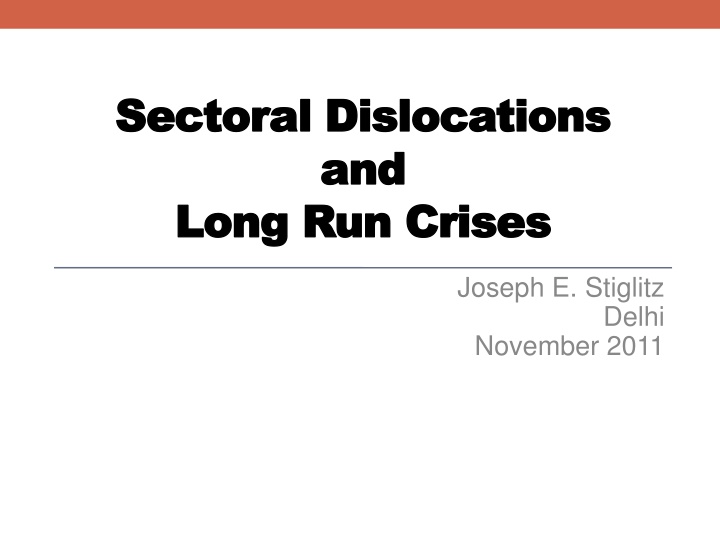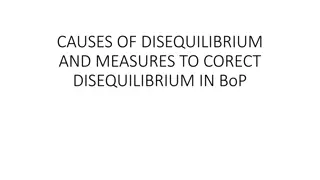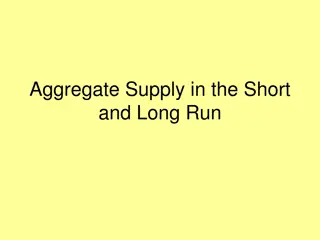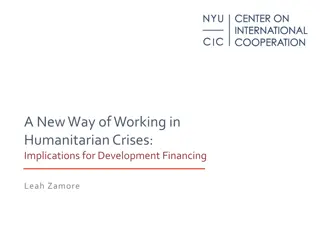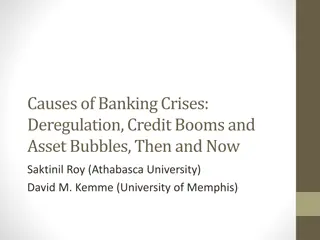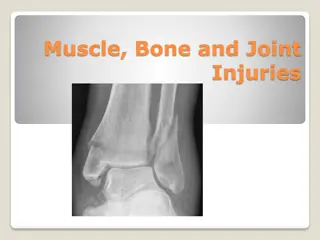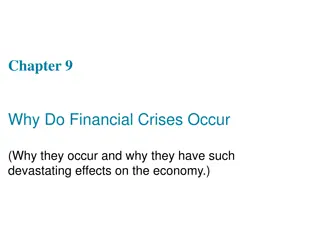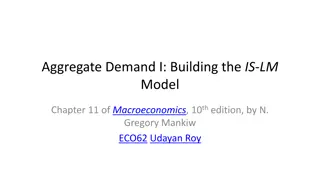Sectoral Dislocations and Long Run Crises in the Economy
Explore the deep impacts of sectoral dislocations and long run crises on the economy through insights from Joseph E. Stiglitz. Delve into comparisons between the recent recession and the Great Depression, reevaluate prevailing views on the financial system, and consider evidence challenging traditional perspectives. Discover how structural transformation shapes economic downturns and the need for adaptive strategies in times of uncertainty.
Download Presentation

Please find below an Image/Link to download the presentation.
The content on the website is provided AS IS for your information and personal use only. It may not be sold, licensed, or shared on other websites without obtaining consent from the author.If you encounter any issues during the download, it is possible that the publisher has removed the file from their server.
You are allowed to download the files provided on this website for personal or commercial use, subject to the condition that they are used lawfully. All files are the property of their respective owners.
The content on the website is provided AS IS for your information and personal use only. It may not be sold, licensed, or shared on other websites without obtaining consent from the author.
E N D
Presentation Transcript
Sectoral Sectoral Dislocations Dislocations and and Long Run Crises Long Run Crises Joseph E. Stiglitz Delhi November 2011
This recession and the Great Depression This is the longest period since the Great Depression during which unemployment has been as high as it has been Natural to think about comparisons between the two
Standard view We had a financial crisis a bubble We need to fix banking system We needed a short term stimulus to plug hole until banking system repaired Once repaired we can go on as usual
Alternative view Before the crisis the US (and to a large extent the global) economy was sick, supported by a real estate bubble, which led to a consumption bubble Bottom 80% of Americans were consuming roughly 110% of their income Not sustainable
While bubble hid underlying problems, it left in its aftermath additional problems Excess capacity in real estate Excess leverage Major mistake of administration was to think that fixing the banking system would suffice But they didn t succeed in restoring lending But even deleveraging won t suffice to restore economy Won t (and shouldn t) return to world with consumption 110% of income
Evidence against prevailing view Financial sector has been largely repaired and yet the economy has not recovered Large enterprises have no shortage of funds Investment (outside of real estate) has almost returned to normal couldn t expect any better given weak demand Real estate won t return to normal any time soon
Deep downturns and structural transformation Great Depression was a period of structural transformation move from agricultural to industry Great Recession is another period of structural transformation (from manufacturing to service sector, induced by productivity increases and changes in comparative advantage brought on by globalization) Rational-expectations models provide little insights in these situations Periods of high uncertainty, information imperfections
Structural transformations may be associated with extended periods of underutilization of resources With elasticity of demand less than unity, sector with high productivity has declining income There may be high capital costs (including individual- specific non-collateralizable investments) associated with transition but with declining incomes, it may be impossible to finance transition privately Capital market imperfections related to information asymmetries Declining incomes in trapped high-productivity sector has adverse effect on other sectors
Contrast with results where there is perfect mobility Productivity improvements can lead everyone to be better off Though normally there are distributive consequences Gainers could compensate losers
Distorted economy (e.g. associated with bubble) can give rise to analogous problems Labor trapped in bloated construction sector and financial sectors This crisis has elements of both Movement out of manufacturing has been going on for a long time But problems compounded by cyclical problems
Basic model Two sectors (industry, agriculture) (1) = DAA(p, p ) + E DMA(p , w* ) (2) H(E) = DAM(p, p ) + E DMM(p , w* ) +I is the labor force in agriculture, (1 - ) is the labor force in industry, is productivity in agriculture, Dijis demand from those in sector i for goods from sector j w* is the (fixed) efficiency wage in the urban sector, I is the level of investment (assumed to be industrial goods), p is the price of agricultural goods in terms of manufactured goods, which is chosen as the numeraire, and E is the level of employment (E 1 - ); and where we have normalized the labor force at unity.
Basic result Normally (under stability condition, other plausible conditions) with immobile labor An increase in agricultural productivity unambiguously yields a reduction in the relative price of agriculture and in employment in manufacturing. The result of mobility-constrained agricultural sector productivity growth is an extended economy-wide slump
Figure: effects of an increase in agricultural productivity.
Great Depression From 1929 to 1932, US agriculture income fell more than 50% While there had been considerable mobility out of agriculture in the 1920s (from 30% to 25% of population), in the 1930s almost no outmigration Labor was trapped Could not afford to move High unemployment meant returns to moving low
Government expenditures Under the stability condition, an increase in government expenditure increases urban employment and raises agricultural prices and incomes Even though problem is structural, Keynesian policies work Even more effective if spending is directed at underlying structural problem
Structural transformation Economy will be moving away from manufacturing towards service But housing and financial services are already overbloated Health and education, etc. will need to be expanded And these depend heavily on public funding Constraints on public funding will make the transition all the more difficult
Figure: Impact of Keynesian stimulus: an increase of G increases both employment and rural prices
Emerging from the Great Depression New Deal was not big enough to offset negative effects of declining farm income And much of federal spending offset by cutbacks at state and local level Analogous to current situation, where government employment is now lower by 700,00 than it was before crisis Local government alone has lost 550,000 since the peak of employment in September 2008
War WWII was a massive Keynesian stimulus Moved people from rural to urban sector Provided them with training Especially in conjunction with GI bill It was thus an industrial policy as well as a Keynesian policy Forced savings during War provided stimulus to buy goods after War In contrast to the legacy of debt now
Wages In model, under normal condition, lowering urban wages lowers agricultural prices and urban employment High (rigid) wages are not the problem Lowering wages would lower aggregate demand worsen the problem In this crisis, the US country with most flexible labor market has had poor job performance, worse than many others
An aside on irrelevance of standard macro-models Since such structural transformations seldom occur, rational expectation models are not of much help Since the central issue is structural, aggregate model with single sector not of much help Since among major effects are those arising from redistribution, a representative agent model is not of much help Since central issue entails frictions in mobility, assuming perfect markets is not of much help Problems exacerbated by efficiency wage effects
An aside on current interpretations of the Great Depression Banking crisis was a result of the economic downturn, not a cause But financial crisis can help perpetuate downturn Standard interpretation has it that if only the Fed had expanded money supply, Great Depression would have been avoided; monetary contraction caused the Depression But we ve had a massive expansion of money base yet economy is still very weak
Global perspective Increase in productivity in manufacturing will limit total number of jobs in sector But changing comparative advantage will mean that US, Europe will get a smaller fraction of these jobs Even greater sectoral adjustment
Other factors weakened global aggregate demand before crisis Growing inequality partially related to sectoral transformation Oil price boom transferred resources to oil rich countries Build up of reserves in emerging countries partially a result of mismanagement of 1997 crisis Two of these factors have become worse since the crisis unstable response
Towards a New Macroeconomics Should be clear that standard models were ill- equipped to address key issues discussed above Assumptions ruled out or ignored many key issues Many of risks represent redistributions How these redistributions affect aggregate behavior is central New Macroeconomics needs to incorporate an analysis of Risk, Information, Institutions, Stability, set in a context of Inequality Globalization Structural Transformation
With greater sensitivity to assumptions (including mathematical assumptions) that effectively assume what was to be proved (e.g. with respect to benefits of risk diversification, effects of redistributions)
Concluding remarks Models and policy frameworks (including many used by central banks) contributed to their failures before and after the crisis And also provide less guidance on how to achieve growth with stability (access to finance) Fortunately, new models provide alternative frameworks Many of central ingredients already available Credit availability/banking behavior Credit interlinkages Sectoral analysis Distributional analysis
More broadly, sensitive to (i) agency problems; (ii) externalities; and (iii) broader set of market failures Models based on rational behavior and rational expectations (even with information asymmetries) cannot fully explain what is observed But there can be systematic patterns in irrationality, that can be studied and incorporated into our models
Concluding remarks Less likely that a single model, a simple (but wrong) paradigm will dominate as it did in the past Trade-offs in modeling Greater realism in modeling banking/shadow banking, key distributional issues (life cycle), key financial market constraints may necessitate simplifying in other, less important directions Complexities arising from intertemporal maximization over an infinite horizon of far less importance than those associated with an accurate depiction of other aspects of the economy (sectoral transformation; financial markets)
New policy frameworks New policy frameworks need to be developed based on this new macroeconomic modeling Focus not just on price stability but also in financial stability
References Domenico Delli Gatti; Mauro Gallegati; Bruce C. Greenwald; Alberto Russo; Joseph E. Stiglitz, Sectoral Imbalances and Long Run Crises, presented to IEA meeting, Beijing, July, 2011. Rethinking Macroeconomics: What Failed and How to Repair It, Journal of the European Economic Association, 9(4), pp. 591-645.
